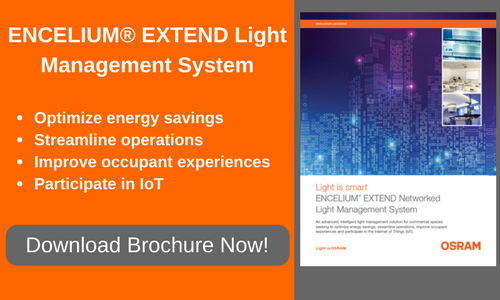Software Takes Center Stage in Commercial Light Management Systems
 There is a revolution happening in commercial lighting. Networked light management systems are now considered essential for realizing maximum energy savings. Due to energy code requirements, they are increasingly becoming a requirement of standard lighting applications. As the popularity increases and code requirements tighten, the software that runs these systems becomes more important.
There is a revolution happening in commercial lighting. Networked light management systems are now considered essential for realizing maximum energy savings. Due to energy code requirements, they are increasingly becoming a requirement of standard lighting applications. As the popularity increases and code requirements tighten, the software that runs these systems becomes more important.
In previous posts, we have discussed how networked light management systems with sensors in every luminaire form the central nervous system of IoT in every smart building. Software is the brain that runs that intelligent, sensor-laden light management system. It is the command center that controls every luminaire and lighting network sensor in the building.
Networked lighting controls can save 35% or more of lighting energy use in commercial buildings while providing a host of additional capabilities and benefits. The software that runs these systems plays a key role in commissioning, operating, and collecting data from sensors on the lighting network.
Commissioning
Software varies depending on the type of networked light management system and the desired level of owner interaction. Setting up a networked lighting system used to be cumbersome and required highly trained personnel. However, that is changing. Just as we see in the consumer world, the user interface to complex software is becoming more intuitive and easier to use -- hiding the complexity of the functionality it provides. Today, light management software is portable and is regularly accessed on almost any device including smart phones, tablets, as well as computers.
Some light management systems that are well-suited for small and medium-sized buildings, use software for setup but then run on autopilot. However, the biggest efficiencies result from more robust systems that are centralized, enabling owners to remotely manage lighting via a web-based interface with the operating software residing on an on-site server or in the cloud. These packages provide flexibility and granularity that gives facility managers and their staff greater control for setting up zones, schedules, and control profiles.
Operations
Software has revolutionized lighting operations. It now allows you to modify and fine-tune lighting to suit individual occupant needs. Depending on the system, the software may be able to execute control strategies that go beyond energy savings and focus on occupant comfort and productivity. For example, research supports the positive effect natural light has on human health and daylight harvesting takes advantage of natural lighting. Task tuning creates the right level of light for the activity in a specific area, helping increase worker productivity and comfort levels.
Collecting Data
One of the most exciting aspects of light management software is the ongoing collection of environmental data from networked sensors. As the Internet of Things (IoT) develops, system software will play an active role in data acquisition for new insights used in a range of smart building applications.
IoT brings light management systems to a new level. Think of it as smart lighting on steroids. While smart lighting is able to bring efficiencies and automation to the lighting system, the addition of IoT tells a broader story about the space, the occupants, and the building itself. More sensors will be integrated and we can learn about occupancy traffic patterns, space utilization and thermal mapping. Location information will be incorporated for internal beaconing and wayfinding. Raw sensor data will be used in third party applications to improve business processes.
The Right System for You
There are all types of things to consider when selecting a smart lighting system that’s right for you and the commercial space you manage. In a recent tED Magazine article, Paul Matthews, product marketing manager at OSRAM said, “Key features that should be in any of these new software packages are simplicity, portability, and training. When deciding between typical and more advanced capabilities in a light management system software package, balance the needs of the customer with the value of the added complexity, keeping it as simple as possible."
Topics: Lighting Controls

.png)
